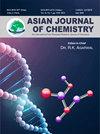Copper and Nitrogen co-doped ZnO Nanomaterials with Enhanced Photocatalytic and Antibacterial Activities
Q4 Chemistry
引用次数: 0
Abstract
This work demonstrates the enhanced photocatalytic and antibacterial activities of copper and nitrogen-co-doped ZnO (Cu-N-ZnO) nanomaterials deposited onto soda-lime glass using a low-cost chemical approach. The effect of combined Cu-N doping is significant on the structure, properties, and performance of ZnO, as revealed from the characterization results. The synthesized materials crystallize in a hexagonal wurtzite structure of ZnO with a high degree of crystallinity, according to X-ray diffraction (XRD) experiments. The scanning electron microscopy (SEM) analysis indicated a uniformly distributed morphology with spherical-like ZnO nanoparticles. The optical studies revealed that the band gap decreases significantly in 5% Cu-5% N co-doped ZnO (2.89 eV) compared to intrinsic ZnO (3.36 eV). The photocatalytic and antibacterial activities of the samples were evaluated by the degradation of methylene blue dye in aqueous media and the inactivation of E. coli bacteria under visible light irradiation. The 5% Cu-5% N doped ZnO showed the highest dye degradation efficiency, which was 64.44% higher than that of the intrinsic ZnO and inactivated 62.53% more bacteria in the presence of light compared to that in a dark condition. Moreover, Cu-N co-doped ZnO inactivated 79.06% and 23.22% more bacteria than bare glass slides and ZnO under visible light irradiation, respectively.铜氮共掺杂氧化锌纳米材料具有更强的光催化和抗菌活性
这项研究利用一种低成本化学方法,证明了沉积在钠钙玻璃上的铜氮复合掺杂氧化锌(Cu-N-ZnO)纳米材料具有更强的光催化和抗菌活性。表征结果表明,铜氮联合掺杂对氧化锌的结构、性质和性能有显著影响。根据 X 射线衍射(XRD)实验,合成的材料结晶为六方菱锌矿结构的氧化锌,具有很高的结晶度。扫描电子显微镜(SEM)分析表明,氧化锌纳米粒子呈均匀分布的球状形态。光学研究表明,与本征 ZnO(3.36 eV)相比,5% Cu-5% N 共掺杂 ZnO 的带隙显著减小(2.89 eV)。在可见光照射下,通过降解水介质中的亚甲基蓝染料和灭活大肠杆菌,评估了样品的光催化和抗菌活性。5% Cu-5% N 掺杂氧化锌的染料降解效率最高,比固有氧化锌高出 64.44%,在光照条件下比黑暗条件下多灭活 62.53% 的细菌。此外,在可见光照射下,Cu-N 共掺杂氧化锌灭活的细菌数量分别比裸玻璃片和氧化锌多 79.06% 和 23.22%。
本文章由计算机程序翻译,如有差异,请以英文原文为准。
求助全文
约1分钟内获得全文
求助全文
来源期刊

Asian Journal of Chemistry
化学-化学综合
CiteScore
0.80
自引率
0.00%
发文量
229
审稿时长
4 months
期刊介绍:
Information not localized
 求助内容:
求助内容: 应助结果提醒方式:
应助结果提醒方式:


